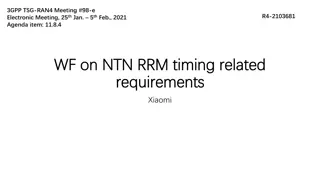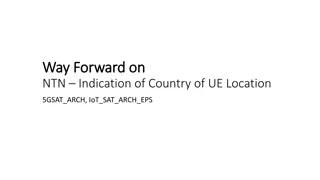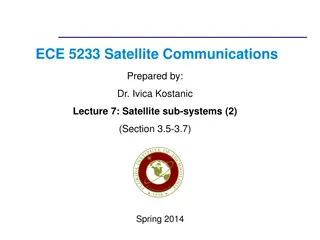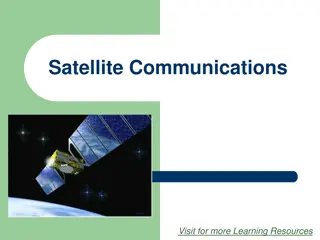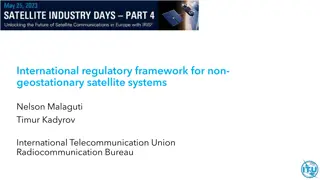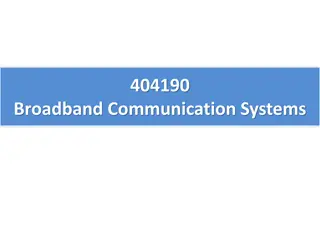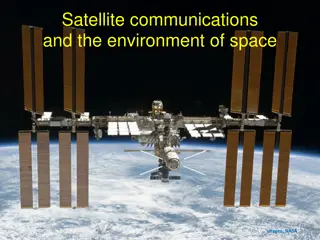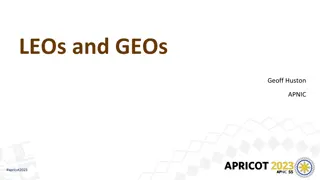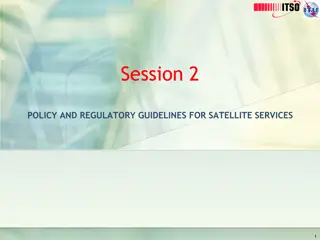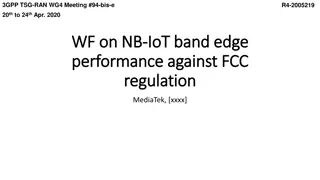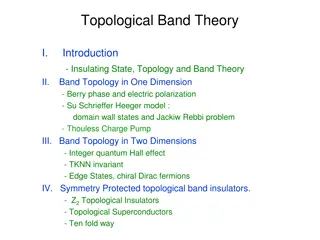Ka-Band as Exemplary Band for NTN-NR in Satellite Services
Discussing the Ka-Band as a key frequency band for Non-Terrestrial Network-New Radio (NTN-NR) in satellite services, addressing its importance in enabling broadband access and bridging the digital divide. Proposals for endorsing Ka-Band, technical aspects, and studies conducted within 3GPP are highlighted.
Download Presentation

Please find below an Image/Link to download the presentation.
The content on the website is provided AS IS for your information and personal use only. It may not be sold, licensed, or shared on other websites without obtaining consent from the author. Download presentation by click this link. If you encounter any issues during the download, it is possible that the publisher has removed the file from their server.
E N D
Presentation Transcript
RP-211524 a revision of RP-211255 Agenda Item: 9.7.2.2 Type: Discussion Document for: Decision 3GPP TSG RAN 92-e June 14-18, 2021 Proposed WF for NTN-FR2 and Ka-Band Handling Aspects Source: Hughes/EchoStar, ESA, Thales, Inmarsat, Fraunhofer HHS, Fraunhofer IIS, Intelsat, Kepler, Mitsubishi, Panasonic 1
FR2 and Ka Band spectrum for Satellite Services Allocated satellite frequency bands in between FR1, FR2 Ka UL Ka UL Ka Band can be considered as NTN - FR2 band 2
Why Ka Band can be considered as NTN-FR2 exemplary band Not a new subject in 3GPP NR-NTN in Ka band has been consistently considered since the begining of the study phase of NTN in 3GPP (see in annex, relevant TDocs submitted to RAN plenary and RAN4) Rational for NTN-FR2 Satellite access that operate in bands above 10 GHz provides essential broadband services to VSAT and ESIM user equipment The benefits of satellite broadband access are increasingly recognized as having significant social and economic importance especially to address the digital divide The handling of Ka-band for NTN-NR is essential to enabling support of the main NTN scenarios in Rel-17 It will pave the way for the definition of other bands above 10 GHz (i.e. Ku & Q/V band) as an independent release WI 3
Proposed WF (Revised based on early round of [92-e-16-NR-NTN-WI]) Proposal 1: RAN#92-e to endorse Ka Band as the exemplary band for NTN-NR above 10 GHz for GEO and NGSO based satellite access. Proposal 2: The RAN4 technical aspects associated with the deployment of NTN in FDD mode in satellite bands above 10 GHz can be identified/characterized as part of an analysis to be started after March 2022, prior to the normative work or once FR1 NTN coexistence study is stable enough
Annex Annex RP RP- -211255 211255 5
TDoc submitted to RAN and RAN4 In section 6.0 of TR 38.821, Ka-Band had been comprehensively studied and calibrated for the Link-Level and System-Level Evaluations as the band for NTN-NR in the FR2 range. As a result, Ka-band had been included in the Recommendations on the way forward in section 9.0 of TR 38.821, and was a part of NTN-NR WID. NTN-FR2 and Ka-band had been consistently proposed in multiple RAN Plenary and RAN4: RAN4 RAN Plenary RAN4#95-e R4-2006613 - New WID FR2 for NR based Satellite networks RAN#84 RP-190995 - Motivation for NWI on Frequency Bands for NR Based Satellite Access RAN4#97-e R4-2014467 - Possible FR2 exemplary band for NR based satellite networks RAN#87-e RP-200107 - Candidate FR2 Frequency Band for NR Based Satellite Access RAN4#98-e R4-2102374 - Discussion on satellite bands outside FR1/FR2 range for NR based satellite networks RAN#88-e RP-200638 New WID FR2 for NR based Satellite networks RAN4#99-e R4-2110813 - Discussion of FR2 (Ka/Ku) Satellite bands for NR based satellite networks RAN#90-e RP-202732 About fixed and moving platform mounted device for NTN RAN#91-e RP-210439 Handling of satellite Ka-band for NR-NTN exemplary band in Rel-17 RAN4#99-e R4-2110993 - About Ka-band proposed for NR-NTN in Rel-17
RAN#90-e Agreements (RP-202907) 6.1 Handling of NTN bands Proposal 1: In RAN4, the WID NR-NTN-solutions will define the generic and core requirements and consider at least one example satellite band. RAN4 to decide based on technical considerations which band(s) to consider as exemplary band for the WI NR-NTN-solutions , with at least the pre-condition that the intended usage is compliant with ITU-R Radio Regulations. Proposal 2: More satellite bands for NTN use can be proposed in RAN4 as long as its intended usage is compliant with radio regulations via separate satellite band specific WIs once progress on generic and core requirements is considered sufficient by RAN4. Proposal 3: The proponents of a RAN4 led satellite band specific WI are expected to reference all the relevant sources (including but are not limited to ITU-R Radio Regulations, relevant national regulations, pre-existing Harmonized Standards developed for example in ETSI, coexistence studies approved by regulatory bodies and/or 3GPP specifications) and contribute to the definition of the requirements that should be met. Moreover they shall clarify the use case scenarios and architectures (e.g. orbit, altitude, type of UE, duplex mode, channel bandwidth, SCS...) provided that the use case scenarios and architectures are within the scope of WID NR-NTN-solutions in order to define the requirements. Proposal 4: Traditional 3GPP work for developing generic requirements, such as inter-carrier co-existence to decide ACLR etc. should be followed where possible but may have to be adapted for the satellite case. Adaptations if needed shall be defined by RAN4. Satellite bands introduced in 3GPP for NTN shall neither impact the existing specifications of nor cause degradation (in the sense of RAN4 co-existence studies) to present and future networks in 3GPP specified terrestrial bands Note 1: The degradation caused to present and future networks in 3GPP specified terrestrial bands shall be understood as the performance degradation caused by the transmission of a NTN channel onto an adjacent TN channel. Simulations should be set such that no more than 5% loss in average and 5th percentile throughput in the adjacent channel of the victim network is seen in the same manner as Rel-15 NR. Note 2: Adjacent channel Co-existence analysis between TN (TN base station transmit) channel specified in 3GPP and NTN (NTN base station receive) channel shall not cause impacts to existing specifications of network in 3GPP specified TN band. Proposal 5: The scope and work load associated to adjacent channel co-existence study(ies) between HAPS and TN in existing 3GPP band(s) allowed by regulation for HAPS as IMT BS operation shall be clarified before being considered to be part of the Rel-17 NR-NTN-solutions WI.
RAN#91-e Agreements (RP-210791) 6.1 Ka band handling aspects Proposal NTN-1. 1: For frequencies above 10 GHz, any work can be limited to VSAT, ESIM service and terminals. Proposal NTN-1.2: The Satellite Ka band refers to [17.3 20.2 GHz] on the downlink and [27.0 30.0 GHz] on the uplink as allocated by ITU-R to satellite services.Some of this range is designated as FSS and some as MSS. Proposal NTN-1.3: Before specifying support for the satellite Ka band, RAN recognize the need to carry out an analysis in RAN4 to identify further technical issues, associated to the deployment of NTN supported by NR (FDD mode) in the satellite Ka band. Proposal NTN-1.4: Any RAN4 satellite Ka band analysis is complementary to the study (focused on terrestrial networks) already carried out on 7-24 GHz that resulted with the TR 38.820. Proposal NTN-1.5: RAN recognizes the need to carry out FR2 coexistence analysis with VSAT/ESIM in UL Satellite Ka band in complement to the on-going FR1 coexistence analysisin case a decision is made to include Ka band. Proposal NTN-1.6: For any satellite Ka band analysis, it is up to RAN4 to discuss simulation assumptions such as the Satellite and UE RF characteristics, UE density, Deployment and Coexistence scenarios, system level parameters for adjacent channel coexistence analysis and relevant regulatory/pre-existing standardization sources. Proposal NTN-1.7: TN bands, if any, in coexistence with DL Satellite Ka band (17.3 20.2 GHz) needs to be identified. The outcomes of the 7-24 GHz SI in TR 38.820 Study on the 7 to 24 GHz frequency range for NR should be taken into account and can be re-used.
RAN4#99-e Outcomes The following proposals were agreed by seven companies. The concerns of opposing minority are not substantiated with convincing technical arguments: Candidate Proposal 4-1-1-1: Should there be any NTN FR2 study (coexistence) phase before the introduction to specification/normative phase? Candidate Proposal 4-2-1-1: If yes, NTN FR2 coexistence studies in Rel-17 should consider: RAN4 will use UL (27-30 GHz) frequency range of Ka band to do co-existence study in Rel-17 NR-NTN WI; Ka band (UL)/FR2 co-existence analysis can be started once the S band/FR1 co-existence analysis principles are stable enough; The actual started time need to be checked at August meeting. Other bands such as Ku & Q/V band will leverage the FR2 co-existence study approach in the future. Note: Huawei, Ericsson still have concern on above proposals. Candidate Proposal 4-2-2-1: Consider the uplink part of satellite Ka band , corresponding with the 27.0 30.0 GHz range, which includes both FSS and MSS denomination, since the provision of VSAT and ESIM services from GSO and NGSO is allowed in FSS as well as MSS denominated spectrum within said range Candidate Proposal 4-3-1-1: It has been clarified throughout the SI and WI definition that NTN covers both VSAT and ESIMs/ESOMPs (which are a type of mobile VSATs operating in FSS spectrum). VSAT and ESIM operates in the entire Ka-band, hence, the frequency bands considered for 3GPP NTN RAN4 work should include spectrum relevant to VSAT and ESIM/ESOMP operation. RAN4 to consider defining the entire Ka Band as an NTN-NR band in FR2 range for GEO and NGSO based satellite access as proposed in RP-200638.



